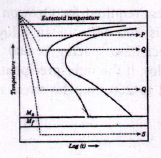11. Malleabilisation heat treatment is performed on
12. What are the crystal structure of Cu, AI, Si, Zn and Ge?
13. Match the basic strengthening mechanisms in the following materials.
Group-I
Group-II
P. 60 : 40 brass is stronger than 70 : 30 brass.
1. Case hardening
Q. An automobile gear made from 0.6% C steel and quenched in water from a temperature of 850°C.
2. Strain hardening
R. Tungsten filament drawn at a temperature of 400°C.
3. Martensitic strengthening
S. A ball bearing heated in furnace in ammonia atmosphere.
4. Second phase strengthening
| Group-I | Group-II |
| P. 60 : 40 brass is stronger than 70 : 30 brass. | 1. Case hardening |
| Q. An automobile gear made from 0.6% C steel and quenched in water from a temperature of 850°C. | 2. Strain hardening |
| R. Tungsten filament drawn at a temperature of 400°C. | 3. Martensitic strengthening |
| S. A ball bearing heated in furnace in ammonia atmosphere. | 4. Second phase strengthening |
14. In a dilute solid solution of nickel and carbon in y-iron.
15. Match the heat treatment for an eutectoid steel shown in the TTT diagram below (as P, Q, R and S) with the resulting microstructure listed below:
1. Fine pearlite
2. martensite
3. Bainite
4. Coarse pearlite

1. Fine pearlite
2. martensite
3. Bainite
4. Coarse pearlite

16. Match the phenomena listed in Group I with the possible mechanisms in Group II.
Group I
Group II
P. Fatigue
1. Grain boundary sliding
Q. Creep
2. Slip band extrusion and intrusion
R. Strain hardening
3. Cottrell atmosphere
S. Yield point phenomenon
4. Dislocation interaction
| Group I | Group II |
| P. Fatigue | 1. Grain boundary sliding |
| Q. Creep | 2. Slip band extrusion and intrusion |
| R. Strain hardening | 3. Cottrell atmosphere |
| S. Yield point phenomenon | 4. Dislocation interaction |
17. An Al 4.5 mass% Cu alloy solutionising at 500°C, quenched to room temperature and aged at 200°C for 2 hrs is found to exhibit an increase in hardness. Theprimary mechanism contributing to increased hardness is
18. The low angle grain boundary occurs when the orientation difference between the adjacent grains is of the order of
19. An Fe - 3 wt % C - 1 wt % Si alloy is cooled very slowly from the liquid state to a temperature of 1023 K. Thereafter, it is cooled in air. The microstructure at room temperature will consist of
20. An annealed plain carbon steel, showing fully pearlitic microstructure, has a carbon content of . . . . . . . . wt%.
Read More Section(Physical Metallurgy)
Each Section contains maximum 100 MCQs question on Physical Metallurgy. To get more questions visit other sections.
